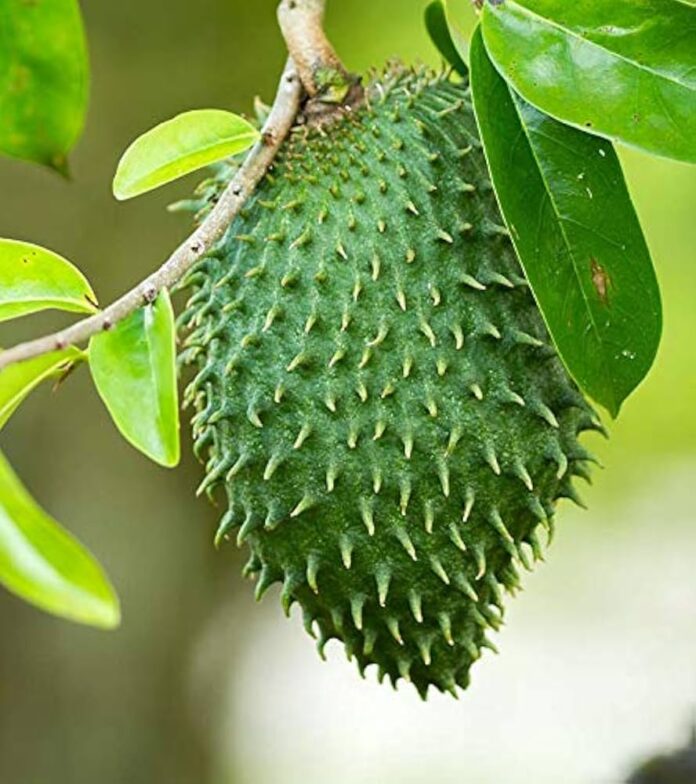Madhumati Tyagi and Sunil Kumar D.
Lakshman Phal also known as soursop or Annona muricata is an amazing tropical fruit that is native to the Caribbean, Central America and India. The term Annona means ‘annual harvest’ in Latin. This bushy tree can grow up to 6 meters tall with broad, oblong leaves and a heart-shaped green fruit covered in small thorns on its outer skin.
The Lakshman phal is bright green, spiny, spherical, sweet, sour, creamy, and delicious. It resembles Sitapahal/custard apple as it has creamy pulp inside with blackish brown seeds. There are nearly 119 different species of this fruit across the globe. However, only seven species and one crossbreed of this fruit are cultivated for consumption. Apart from the fruit, its leaves, stem, flowers, etc. have amazing natural compounds and medicinal benefits to cure many diseases. Lakshman fruits are a lesser-known fruit and not as common as apples or bananas, however, these fruits from the Annonaceae family are rich in nutrients and offer unique flavors.
What are the nutritional values of Lakshman Phal?
Lakshman Phal fruit is not just visually unique but also offers a delightful taste with its creamy white pulp filled with black seeds. The fruit’s flavor can be best described as a delicious blend of pineapple and strawberry. It is commonly used to make fruit nectar, refreshing smoothies, revitalizing juice and even used in the ice creams.
What are the different ways to Consume Lakshman Phal?
The most common way to consume a fresh ripen Lakshman phal is to cut in half and the creamy white pulp can be scooped out and eaten directly as fresh fruit remove the black seeds before eating the fruit with a fork or your own teeth. 2) You can blend the pulp of the fruit with water to make a refreshing smoothie. 3) You can use the fruit pulp to make ice cream, sorbet, or desserts such as pies, tarts, or as a topping for cakes and pastries. 4) The leaves of the Lakshman phal tree are often boiled to make tea due to their inherent medicinal benefits. The tea is packed with essential nutrients and antioxidants; this juice promotes good health, metabolism, bones, and boosts your immune system. The tea helps kill cancer cells, fight bacteria, improves gastrointestinal health and stabilize blood sugar levels.
What are the health benefits of Lakshman Phal?
1) Kills Cancer Cells: Lakshman phal leaves contains compounds like acetogenins which have been observed to inhibit or slow down the growth of cancer cells in case of colon, breast, prostate, lung cancer, and pancreatic cancers. Unlike a chemotherapy session where a patient suffers nausea, hair loss and weight loss, eating Lakshman phal kills cancer cells in the body without any of these side effects. The antioxidants and phytochemicals present in the fruit may help reduce the risk of developing breast cancer, making it a valuable addition to a breast cancer diet by preventing the proliferation of malignant cells.
2) Prevents Urinary Tract Infections (UTIs): The abundance of Vitamin C in Lakshman phal helps maintain the acidic environment in urine, thus reducing the likelihood of bacterial growth that leads to UTIs. Therefore, regular consumption of this fruit may prevent UTIs, particularly among women who are more susceptible to such infections.
4) Prevents Osteoporosis: This fruit is rich in minerals like calcium and magnesium – vital for bone health. Regular intake of Lakshman phal can help prevent osteoporosis.
5) Prevents Constipation: The high dietary fiber content in Lakshman phal aids digestion and promotes regular bowel movements. Regular consumption od this fruit can alleviate constipation and foster overall digestive health.
6) Prevents Leg Cramps: The potassium content in Lakshman phal can be beneficial in preventing leg cramps. Potassium is crucial for muscle function and helps regulate fluid balance in the body, subsequently reducing the occurrence of cramps during physical activity.
7) Prevents Water Retention: Lakshman phal can also aid in preventing water retention, due to potassium content that helps balance sodium levels in the body, mitigating bloating and excess fluid accumulation.
8) Increases Stamina and Energy: Regular consumption of Lakshman phal can contribute to increased stamina and energy levels, owing to its rich nutritional profile, including vitamins and minerals.
9) Keeps Bones Healthy: The calcium and magnesium present in Lakshman phal are essential for maintaining strong bones. Regular consumption of this fruit can enhance bone density and reduce the risk of fractures and osteoporosis.
10) Improves Sleep: Lakshman phal is believed to have calming properties that may help improve sleep quality, promote relaxation and reduce anxiety, facilitating better sleep patterns.
11) Maintains Good Cholesterol: The fiber content aids in reducing LDL (bad cholesterol) while promoting HDL (good cholesterol), supporting cardiovascular health.
12) Soothes Mouth Ulcers: The anti-inflammatory properties of Lakshman phal can be instrumental in treating mouth ulcers by soothing affected areas and speeding up the healing process.
13) Helps Manage Anemia and Migraines: Lakshman phal is rich in iron and plays a crucial role in preventing anemia. Additionally, its antioxidant properties may help alleviate migraine symptoms by reducing inflammation and oxidative stress in the body.
What precautions to keep in mind?
Concisely, it is vital to consume it responsibly. Be aware of potential allergic reactions like itching, swelling or trouble breathing after eating it. Consultation with a healthcare professional is advisable, especially for those with existing health conditions or pregnant and nursing women.







